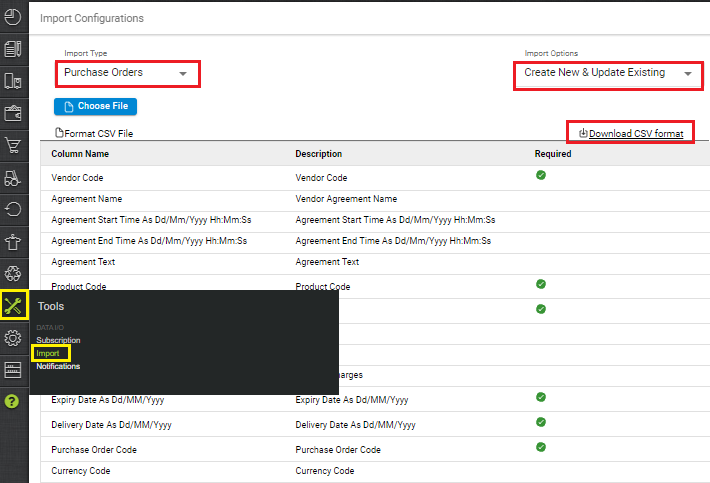Purchase Orders in Bulk
Now, seller can create purchase orders in bulk through Import. The seller can enter multiple Purchase Orders against the Vendor.
Applicability
Version: Enterprise
Traceability: None and ITEM
Procedure
Path: Main Menu (Tools) > Import > Select import as “Purchase Orders”
1- To use, select Create & Update Existing from the Import Option.

2- Download the CSV format and fill in the details.

|
Field Name (M: Mandatory) |
Description/Notes |
|---|---|
|
Vendor Code (M) |
Vendor Code. |
|
Agreement Name |
Vendor Agreement Name. |
|
Agreement Start Time As |
Agreement Start Time As Dd/Mm/Yyyy Hh:mm:ss |
|
Agreement End Time As |
Agreement End Time As Dd/Mm/Yyyy Hh:mm:ss |
|
Agreement Text |
Agreement Text. |
|
Product Code (M) |
Product Code, uniware SKU. |
|
Quantity (M) |
Quantity of SKU. |
|
Unit Price |
Unit Price of SKU. |
|
Discount |
Discount on SKU. |
|
Logistic Charges |
Logistic Charges on purchase order. |
|
Expiry Date As Dd/MM/Yyyy (M) |
Expiry Date As DD/MM/YYYY |
|
Delivery Date As Dd/MM/Yyyy (M) |
Delivery Date As DD/MM/YYYY |
|
Purchase Order Code (M) |
Purchase Order Code |
|
Currency Code |
Currency Code.
|
| Currency Code |
Currency Code |
3– Save the sheet in default CSV format then Select the option “Choose File” and upload the sheet and press the “Upload File” button.

4– Once the upload has been successful, you can review the uploaded sheet. Right at the top of the screen is the import section where the user can see the success message.
When uploading data fails, you can check it from View import and repeat the task.

Ref: 2031681537
